Earthquakes have been a hot subject over the last couple months around here.
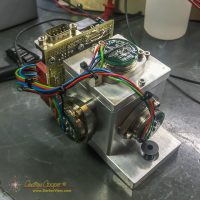
The ongoing collapse of the summit caldera on Kilauea has been generating a daily five point something earthquake. While not powerful enough to damage the facility, these events do show up in the data each night, bumping the telescope, disturbing the tracking, and occasionally ruining an exposure.
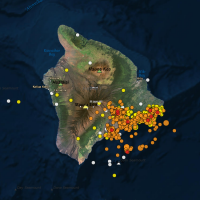
We worry about another strong quake. The magnitude 6.9 event in early May did damage the telescopes. That shake was strong enough to damage the bolts on our radial bearings on Keck 1, the assemblies that keep the telescope centered in the azimuth journal. It took a couple days to repair that damage and return the telescope to service.
There are a couple seismic instruments already on the summit of Mauna Kea, but not inside our facility. While we had discussed getting our own sensor it was always a lower priority than the rest of the list of stuff that needed to get done sooner. No surprise, several new sensors at the various telescopes have been installed over the last months as the earthquake issue has become a daily occurrence.
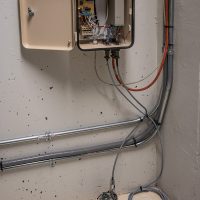
When considering possible damage it is not the earthquake magnitude we need to know. Magnitude is a measurement of energy dissipated at the source, not how much of that energy arrives at our facility. The magnitude does not give any allowance distance to the epicenter, attenuation by the various geologic features betwixt here and there, and the frequencies and forces generated.
A tale of two earthquakes shows this issue clearly. In October, 2006 the island was hit with a magnitude 6.7 earthquake. This quake caused widespread damage across the islands, including at the summit where the damage was enough to cause significant damage to the telescopes. This damage took months and a great deal of effort to repair. While this May’s 6.9 was technically a stronger earthquake, at about the same distance from the mauna, the damage was relatively minor.
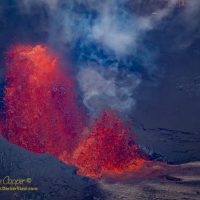
The first sensor used was a commercially available acceleration sensor that I can simply buy. These little modules are sensitive to accelerations of a few milligees and up to &plusminus;2G. Better yet that are already packaged up a convenient module that I can simply bolt onto the floor or telescope.
While the TE sensor works fairly well on the telescope, it just does not have a low enough noise floor for the facility accelerometer down in the foundation. This quiet location allows more sensitivity to be used where the goal is to reliably detect any earthquake the operators might feel and might potentially damage the facility. The logger was just missing events that it should have recorded.
I needed a better sensor. Fortunately I had the bits needed to construct a very good one lying about. Since the data logger had plenty of inputs I had wired in the ability to attach a second sensor from the start, a feature that now proved quite useful.
The second sensor was constructed from three aerospace rated Honeywell QA-1400 accelerometers. These are scavenged from the decommissioned Keck Interferometer which used them to measure and compensate for vibrations in the telescope.
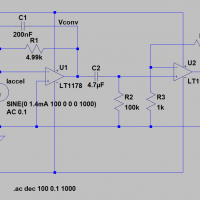
A band pass was incorporated to clean up any noise and to AC couple any DC offset in the sensors out of the system. This AC coupling also removes the static 1g offset due to gravity from the Z axis sensor.
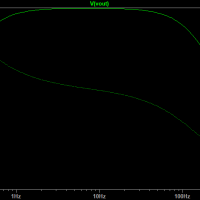
Calibration is fairly easy. A jumper is installed to bypass the AC coupling between amplifier stages allowing the accelerometer to show a static field. You then use the standard 1G field available planet wide to adjust for the desired gain. Position the sensor to place one side down, adjust gain, then reverse the direction to check both polarities, repeat for all three axis. In this case I adjusted for 10V/g.

With the new sensor detecting the summit collapse events has become routine… beautiful and clean plots of these regular events. I can note the lateral and vertical forces, measured with good confidence in the calibration.
Two small circuits were added to weave the system together. To overcome the lack of a time duration trigger (see below) a one-shot built around an LM555 was added. With the output run back into one of the digital inputs on the logger it can be used to end the recording. The LM555 circuit is modified to be re-triggerable, thus the recording will end thirty seconds after the last strong movement.
Also added is an alarm relay. The relay opens in the case of a detected event. This may eventually be tied to the telescope control system to automatically shut things down.
The measurement and logging is done using a DATAQ DI-808 web-based data logger. Featuring 40Hz sampling, 16-bit resolution, and four gigabytes of memory in which to dump that data it does the job.
Despite being a fairly nice unit to start with, there are a few features the DI-808 data logger is lacking. Better triggering is the most glaring omission, multi event type triggering, and most glaringly the ability to log for a specific duration after a trigger
I have noted my suggestions to DATAQ, but do not really expect a useful response. I am seriously considering hacking the unit, finding out if I can break into the operating system to write my own code. I expect to find a small Linux computer inside, it may be possible to change things to suit my needs.
Getting the data files out of the logger is a matter of passwords and CSV files. Not exactly quick or convenient. Thus I wrote a little Python script to grab and plot the data. The data files can be listed out and retrieved via HTTP. I did need the Requests library to handle the authentication and HTTP retrieval. Most of the summit systems are some variant of Linux, thus this script can be run on nearly any station in the facility.
The design goal of the system is pretty simple, and I think I can say it has been met. Record and measure any seismic event that causes a notable shake in the observatory. Make that data available and allow the telescope operators to act on the data.
The question is simple… Do they ignore the event and keep on operating? Do they stop and do a wall around to insect the facility? Do the shut down and wait for the day crew to do a thorough inspection of the facility before operating again?
Equipment in place we can record the trembling ground beneath us. Despite this I suspect my seismic adventures are not over.
Now if our volcano would just settle down a bit.


Wow. Maybe I’m biased but I thought every one of the newer telescopes had something like UKIRT – which is basically on a “floating mount” with shear pins. The bigger earthquakes displace the whole telescope mount (including of course the telescope, which for the night leads to at least pointing problems, being that it is operated remotely) and bend or break the shear pins. The next occasion there is a daycrew (or one is sent up to particularly deal with this – unless the JCMT TSS already did so during the night) the telescope is put back in place and new shear pins put in.